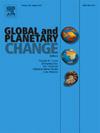一种改进的瞬时总初级生产力模型,它考虑到了阳光照射叶片和阴影叶片对树冠阳光诱导的叶绿素荧光贡献的差异
IF 4
1区 地球科学
Q1 GEOGRAPHY, PHYSICAL
引用次数: 0
摘要
植物的太阳诱导叶绿素荧光(SIF)是通过模拟 SIF-GPP 关系估算总初级生产力(GPP)的有效替代物,这是一种广泛用于评估全球碳汇的方法。然而,大多数 SIF-GPP 模型都忽略了阴影叶片和阳光叶片之间的 SIF 差异,导致 GPP 被低估,尤其是在茂密植被中。本研究旨在区分日照叶和遮光叶对冠层 SIF 和 GPP 的贡献,以完善 SIF-GPP 估算模型。研究使用了代表八个主要生物群落的 40 个涡度协方差(EC)站点的数据和 TROPOMI SIF 卫星数据,进行站点和全球尺度分析。结果表明,阳光照射叶片和阴影叶片对冠层 SIF 的贡献率分别为 80% 和 20%,对冠层 GPP 的贡献率分别为 55% 和 45%。对于特定地点或卫星数据,阳光照射叶片的 SIF-GPP 关系最强(R2 > 0.51, RMSE = 4.03 μmol m-2 s-1, p <0.001)。新的 SIF-GPP 模型包括日照-阴影 SIF 分离,可提高 GPP 估计的准确性(R2 = 0.53,RMSE = 4.38 μmol m-2 s-1,p <0.001)。与利用观测数据建立的模型相比,R2 增加了 0.1,RMSE 减少了 13.26 μmol m-2 s-1,表明 "双叶 "模型能显著改善 SIF-GPP 模型。这项研究证实了日照叶片和遮光叶片对冠层 SIF 和 GPP 的贡献是不同的,忽视这种差异会导致 GPP 估算的系统性偏差。我们关于阳光-阴影 SIF 分离的方法和发现可供其他研究参考,以提高 GPP 估算的准确性。本文章由计算机程序翻译,如有差异,请以英文原文为准。
An improved instantaneous gross primary productivity model considering the difference in contributions of sunlit and shaded leaves to canopy sun-induced chlorophyll fluorescence
Sun-induced chlorophyll fluorescence (SIF) from plants offers an effective proxy for estimating gross primary productivity (GPP) by modeling SIF-GPP relationships, a widely used method to evaluate the global carbon sink. However, most SIF-GPP models ignore SIF differences between shaded and sunlit leaves, resulting in GPP underestimation, particularly in dense vegetation. This study aims to partition the contributions of sunlit and shaded leaves to canopy SIF and GPP to refine the SIF-GPP estimation model. Data from 40 eddy covariance (EC) sites representing eight major biomes and TROPOMI SIF satellite data were used for site-specific and global-scale analyses. Our results showed that the contributions of sunlit and shaded leaves to canopy SIF were 80 % and 20 %, and to canopy GPP were 55 % and 45 %, respectively. For site-specific or satellite data, the SIF-GPP relationships were the strongest for sunlit leaves (R2 > 0.51, RMSE = 4.03 μmol m−2 s−1, p < 0.001). The new SIF-GPP model, including sunlit-shaded SIF separation, can improve the accuracy of GPP estimation (R2 = 0.53, RMSE = 4.38 μmol m−2 s−1, p < 0.001). Compared with the model established with observed data, R2 was increased by 0.1, and RMSE decreased by 13.26 μmol m−2 s−1, indicating that the ‘two-leaf’ model could notably improve the SIF-GPP model. This study confirms the different contributions of sunlit and shaded leaves to canopy SIF and GPP, and ignoring this disparity would induce systematic bias in GPP estimation. Our methods and findings on sunlit-shaded SIF separation can be referenced by other studies to enhance GPP estimation accuracy.
求助全文
通过发布文献求助,成功后即可免费获取论文全文。
去求助
来源期刊

Global and Planetary Change
地学天文-地球科学综合
CiteScore
7.40
自引率
10.30%
发文量
226
审稿时长
63 days
期刊介绍:
The objective of the journal Global and Planetary Change is to provide a multi-disciplinary overview of the processes taking place in the Earth System and involved in planetary change over time. The journal focuses on records of the past and current state of the earth system, and future scenarios , and their link to global environmental change. Regional or process-oriented studies are welcome if they discuss global implications. Topics include, but are not limited to, changes in the dynamics and composition of the atmosphere, oceans and cryosphere, as well as climate change, sea level variation, observations/modelling of Earth processes from deep to (near-)surface and their coupling, global ecology, biogeography and the resilience/thresholds in ecosystems.
Key criteria for the consideration of manuscripts are (a) the relevance for the global scientific community and/or (b) the wider implications for global scale problems, preferably combined with (c) having a significance beyond a single discipline. A clear focus on key processes associated with planetary scale change is strongly encouraged.
Manuscripts can be submitted as either research contributions or as a review article. Every effort should be made towards the presentation of research outcomes in an understandable way for a broad readership.
 求助内容:
求助内容: 应助结果提醒方式:
应助结果提醒方式:


